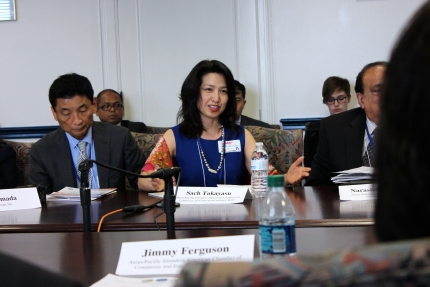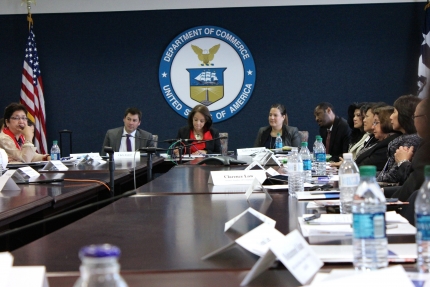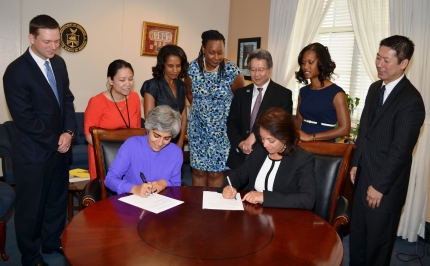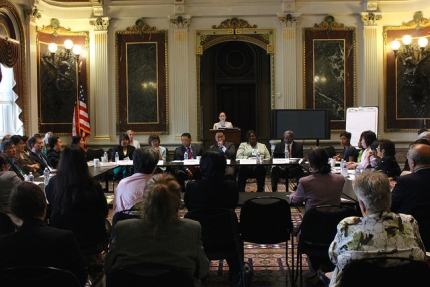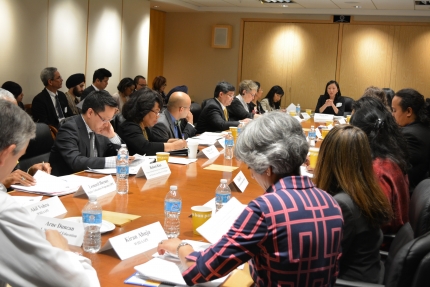Initiative on Asian Americans and Pacific Islanders Blog
Meeting the Needs of Asian American and Pacific Islander Businesses and Entrepreneurs
Posted by on June 5, 2014 at 3:45 PM EDTMore than 1.5 million businesses in the United States are owned by Asian Americans, Native Hawaiians and Pacific Islanders. These firms account for $508.6 billion in spending power nationwide and have resulted in the creation of more than 2.8 million jobs. A vast majority of these companies are small and are fueled almost exclusively on creatively, ingenuity, business innovation and an unparalleled level of entrepreneurial spirit that cannot be found anywhere else in the world.
They include a robotics company designed to entice young people to consider careers in science, technology and engineering; a brick and mortar Boba tea shop that will introduce new flavors and customer enhancements to widen its appeal; a fashion design company that draws inspiration from the cultural diversity of America; and, a shoe designer who incorporates recycled and repurposed paper to create an environmentally friendly consumer product.
On May 5, the White House Initiative on Asian Americans and Pacific Islanders (WHIAAPI) teamed up with the U.S. Department of Commerce’s Minority Business Development Agency (MBDA) and the U.S. Small Business Administration (SBA) by holding a roundtable discussion to address some of the key issues facing business owners, entrepreneurs and corporate leaders in the greater Asian American and Pacific Islander (AAPI) community.
The dialogue between the AAPI business leaders and federal leaders was direct, open, and honest, and included conversations that focused on including small business leaders on international trade missions; having ACE and regional business associations and chambers serve as direct resources to all federal agencies; encouraging the SBA and MBDA to identify, recruit and hire more AAPIs to work within existing Small Business Development Centers and MBDA Business Centers; offering more in-culture and in-language services for the growing number of small businesses established by immigrants from Asia and other parts of the world; and, by working with federal agencies to collect and share disaggregated data pertaining to AAPIs that will ensure that will allow federal agencies and the AAPI business community to develop strategies and tactical plans to address the needs, interests and aspirations of the AAPI business community.
On May 29, WHIAAPI, along with MBDA and the Export-Import Bank, co-hosted the Asia-Pacific Economic Forum Opening Symposium which convened over one hundred business leaders interested in doing business in Asia. It was an excellent opportunity for both senior level government officials and business leaders to learn and discuss ways to better utilize resources in the federal government and the Asia-Pacific region.
A highlight of the event was the signing of the Memorandum of Understanding (MOU) between WHIAAPI and MBDA. The MOU will solidify a partnership between the two agencies and marks the beginning of future programs such as a possible business development program that would provide a range of federal business development services for AAPI businesses to be more successful overseas.
The roundtable discussion and symposium were very successful because all parties were engaged, supportive and focused on finding equitable solutions. Representatives agreed that they must continue to look to each other to find ways to improve access to capital, stimulate economic development and growth, advance U.S. exports, facilitate federal contracting opportunities for small businesses, forge stronger public-private partnerships, and to collect, source and analyze data to ensure that all businesses and communities have the same opportunities to strive for business success.
Bill Imada is a member of the President’s Advisory Commission on Asian Americans and Pacific Islanders.
Learn more aboutClosing the Pay Gap for Asian-American Women
Posted by on June 3, 2014 at 5:28 PM EDTEd. note: This is cross-posted on the U.S. Department of Labor's blog. See the original post here.
Throughout Asian-Pacific American Heritage Month in May, the Labor Department shared the latest data available on the employment status of AAPI workers. Secretary Perez discussed the overall employment situation for AAPI workers, Deputy Secretary Chris Lu wrote about the importance of education and Assistant Secretary Portia Wu described the challenges of long-term unemployment. There’s another issue that I’d like to discuss, one that this administration – and the Labor Department in particular – has made a top priority: equal pay.
As the director of Office of Federal Contract Compliance Programs, my job is to enforce the civil rights of the nearly 22 percent of American workers who are employed by companies that profit from contracts or subcontracts with the federal government. At OFCCP, we make sure that those workers get a fair shot at employment and a fair shake when it comes to placement, promotions and pay.
When taken as a whole, AAPI workers have the highest level of earnings compared to other racial and ethnic groups. Half of full-time AAPI workers earned $987 or more per week in 2013, approximately 14 percent higher than the median weekly earnings of white workers.
Learn more aboutA Collective Focus on Behavioral Health in the AAPI Community
Posted by on June 2, 2014 at 6:03 PM EDTHow do we begin to address behavioral health issues within Asian American and Pacific Islander (AAPI) communities compounded with the need for cultural sensitivity and access to resources? This was the crux of a recent dialogue between community organizations and federal officials involved in advancing the behavioral health of the AAPI community.
During last month’s AAPI Behavioral Health Forum, a Vietnamese woman shared her story of cross-generational trauma, stemming from tragedies experienced during the Vietnam War; a third generation Japanese-American woman described her lack of a sense of belonging associated with her schizophrenia; another Japanese-American woman reflected on her family’s need to deny the cause of death when her cousin died by suicide. These stories were a sobering reminder of the challenges associated with the lived experiences of AAPI individuals, families, and communities with mental and/or substance use disorders.
Throughout the day, federal and community experts discussed current efforts to elevate AAPI behavioral health issues in communities across America and advance behavioral health equity. Forum participants assessed the questions, challenges, and opportunities for each of the four issue areas – data, integrated care, workforce development and community engagement. While exploring these issue areas, participants thought critically about possible next steps to build and strengthen efforts to improve AAPI behavioral health and serve the AAPI community in a culturally and linguistically competent manner.
Learn more about Health CareUnemployment Challenges for AAPI Workers
Posted by on May 28, 2014 at 5:19 PM EDTEd. note: This is cross-posted on the U.S. Department of Labor blog. See the original post here.
As part of our commemoration of Asian-Pacific American Heritage Month, the department has been sharing the latest data highlighting the status of Asian-American and Pacific Islanders in our nation’s labor market.
Secretary Perez kicked off the blog series by talking about the overall employment situation for AAPI communities, and Deputy Secretary Chris Lu followed with a discussion on the importance of expanding opportunities through education for AAPIs. I’m turning to a topic that doesn’t get much attention – AAPIs, when facing unemployment, tend to remain unemployed for a long time.
Asian-Americans, as a group, have the lowest unemployment rate (5.2 percent in 2013) compared to the nation as a whole (7.4 percent in 2013). This fact may mask the challenges Asian-Americans experience when faced with unemployment. While Asians are less likely to be unemployed, those who are face longer durations of unemployment (20 weeks) compared to whites (16 weeks) or Hispanics (15 weeks).
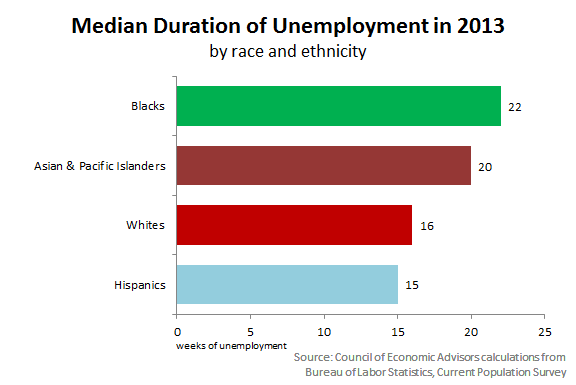 Learn more about , Economy
Learn more about , EconomyWorking with Community Leaders to Improve Educational Outcomes for AANHPI Students
Posted by on May 28, 2014 at 4:56 PM EDTEd. note: This is cross-posted on the U.S. Department of Education blog. See the original post here.
May is Asian American and Pacific Islander Heritage Month, a time for us to celebrate the accomplishments of Asian Americans, Native Hawaiian, and Pacific Islanders (AANHPIs) and their contributions to this great nation. This year’s theme for the month is “I am Beyond,” which captures the aspirations of the American spirit and how Americans of Asian and Pacific Islander descent have always sought to excel beyond the challenges that have limited equal opportunity in America.
As chair of the White House Initiative on Asian Americans and Pacific Islanders, it is important that I hear directly from AANHPI leaders who work with our students and their families every day. Earlier this month, I had the opportunity to meet with community leaders who came from as far as Guam and Hawaii to discuss important issues that face AANHPI students around the country and in the Insular Areas. I was honored to have many key leaders at the Department of Education who have made working with AAPI populations a critical part of their work.
Learn more about EducationCombating the Silent Epidemic of Hepatitis B in the AAPI Community
Posted by on May 28, 2014 at 9:54 AM EDTAs part of CDC and Hep B United’s Know Hepatitis B campaign, this infographic provides information in a visual and easy-to-understand format.
As May is both Asian American and Pacific Islander (AAPI) Heritage Month and Hepatitis Awareness Month, we are reminded of the staggering impact of Hepatitis B in the AAPI community. AAPIs comprise approximately five percent of the U.S. population, but account for more than half of Americans with chronic Hepatitis B. In fact, one in 12 AAPIs is living with chronic Hepatitis B.
As a result of unprecedented coordination and collaboration among federal partners brought about by the U.S. Department of Health and Human Services (HHS)’s Action Plan for the Prevention, Care & Treatment of Viral Hepatitis, which was just updated last month, we can now leverage a number of new tools to support our ongoing awareness efforts. The Plan is the nation’s first comprehensive cross-agency effort to combat viral hepatitis. The Action Plan is also a core element in HHS’s 2014-2015 agency plan for the White House Initiative on AAPIs – we encourage you to submit feedback on the agency plan by May 31.
To help increase awareness of Hepatitis B, one tool, created by the Centers for Disease Control and Prevention (CDC), in partnership with Hep B United, is the multi-lingual Know Hepatitis B campaign, which works with community organizations across the country to raise awareness among AAPIs about the importance of Hepatitis B testing and vaccination. The campaign includes many resources, including PSAs, posters, fact sheets and infographics, available in English, Chinese, Korean, Vietnamese, Burmese, Hmong, Khmer, and Lao, to help expand the availability of culturally and linguistically appropriate Hepatitis B education and outreach materials. In addition, flyers, newspaper ads, and posters are also available for community partners to tailor for their local populations.
Another tool is the CDC’s online hepatitis risk assessment, which we encourage people to share with their loved ones and community members. People should consult with their health care providers about getting tested for hepatitis.
Broader dissemination and use of these tools, as well as tailored outreach to AAPI communities, will hopefully reduce the disproportionate burden of Hepatitis B in the AAPI population. Working together, we can make strides in breaking the silence on this epidemic.
Dr. Howard K. Koh is Assistant Secretary for Health at the U.S. Department of Health and Human Services. Kiran Ahuja is Executive Director of the White House Initiative on Asian Americans and Pacific Islanders.
- &lsaquo previous
- …
- 11
- 12
- 13
- 14
- 15
- 16
- 17
- 18
- 19
- …
- next &rsaquo
White House Blogs
- The White House Blog
- Middle Class Task Force
- Council of Economic Advisers
- Council on Environmental Quality
- Council on Women and Girls
- Office of Intergovernmental Affairs
- Office of Management and Budget
- Office of Public Engagement
- Office of Science & Tech Policy
- Office of Urban Affairs
- Open Government
- Faith and Neighborhood Partnerships
- Social Innovation and Civic Participation
- US Trade Representative
- Office National Drug Control Policy
categories
- AIDS Policy
- Alaska
- Blueprint for an America Built to Last
- Budget
- Civil Rights
- Defense
- Disabilities
- Economy
- Education
- Energy and Environment
- Equal Pay
- Ethics
- Faith Based
- Fiscal Responsibility
- Foreign Policy
- Grab Bag
- Health Care
- Homeland Security
- Immigration
- Innovation Fellows
- Inside the White House
- Middle Class Security
- Open Government
- Poverty
- Rural
- Seniors and Social Security
- Service
- Social Innovation
- State of the Union
- Taxes
- Technology
- Urban Policy
- Veterans
- Violence Prevention
- White House Internships
- Women
- Working Families
- Additional Issues
